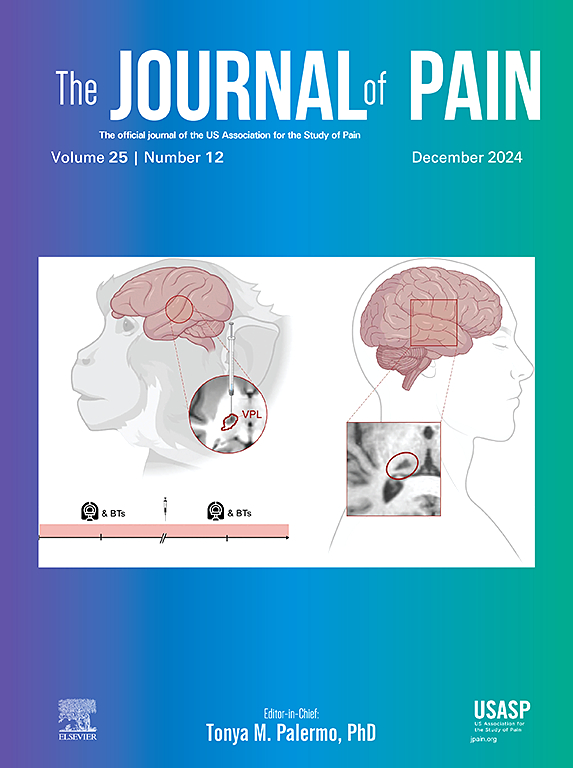评估个人对热烧烤幻觉的敏感性:二维自适应心理物理学方法
IF 4
2区 医学
Q1 CLINICAL NEUROLOGY
引用次数: 0
摘要
在热烧烤错觉(TGI)中,非毒性冷热温度的空间交替会引起类似于有害刺激的灼烧感。以往的研究主要依赖于使用特定的温度值(即 20°C 和 40°C)来研究健康人和病人群体的这一现象。然而,这种方法未能考虑到个体间热敏感性的差异,从而限制了对不同人群的 TGI 反应进行精确评估的能力。为了弥补这一不足,我们创建了二维热烧烤校准(2D-TGC)协议,从而能够高效、精确地估算出每个个体所需的冷热温度组合,以激发灼烧感。通过在 43 名健康参与者中应用 2D-TGC 方案,我们展示了以下主要发现:(1)可使用自适应心理物理方法对 TGI 进行阈值测量。(2)冷暖温度的多种组合可以引起这种现象。(3)该方案有助于确定能引起 TGI 的温度组合,其概率、强度和感知质量水平各不相同,从冰冷到灼热。 (4)TGI 反应性可以作为一个连续变量进行量化,超越了根据无害温度范围内的任意温度值将个体划分为有反应者和无反应者的传统方法。2D-TGC 提供了一种全面的方法来研究热敏感性改变的人群的 TGI,并可与其他方法(如神经影像学)相结合,以阐明造成热痛觉系统知觉错觉的机制。视角:本研究揭示了热烧烤幻觉可以通过心理物理方法进行精确测量。创新的二维热烧烤校准方案可进行个性化温度评估,从而加深我们对不同人群的热敏性变化和热痛觉系统知觉错觉的理解。本文章由计算机程序翻译,如有差异,请以英文原文为准。
Assessing individual sensitivity to the Thermal Grill Illusion: A two-dimensional adaptive psychophysical approach
In the Thermal Grill Illusion (TGI), the spatial alternation of non-noxious warm and cool temperatures elicits burning sensations that resemble the presence of noxious stimuli. Previous research has largely relied on the use of specific temperature values (i.e., 20 °C and 40 °C) to study this phenomenon in both healthy individuals and patient populations. However, this methodology fails to account for inter-individual differences in thermal sensitivity, limiting the precision with which TGI responses can be evaluated across diverse populations. To address this gap, we created a Two-Dimensional Thermal Grill Calibration (2D-TGC) protocol, enabling an efficient and precise estimation of the combinations of warm and cool temperatures needed to elicit burning sensations tailored to each individual. By applying the 2D-TGC protocol in 43 healthy participants, we demonstrated that the TGI can be thresholded using an adaptive psychophysical method, and that multiple combinations of warm and cool temperatures can elicit this phenomenon. More specifically, the protocol facilitated the identification of temperature combinations that elicit TGI with varying levels of probability, intensity, and perceived quality ranging from freezing cold to burning hot. Finally, our results indicate that TGI responsivity can be quantified as a continuous variable, moving beyond the conventional classification of individuals as responders vs. non-responders based on arbitrary temperature values in the innocuous temperature range. The 2D-TGC offers a comprehensive approach to investigate the TGI across populations with altered thermal sensitivity, and can be integrated with other methods (e.g., neuroimaging) to elucidate the mechanisms responsible for perceptual illusions in the thermo-nociceptive system.
Perspective
This study reveals that the Thermal Grill Illusion can be accurately measured using psychophysical methods. The innovative Two-Dimensional Thermal Grill Calibration protocol allows for personalized temperature assessments, enhancing our understanding of thermal sensitivity variations and perceptual illusions in the thermo-nociceptive system across different populations.
求助全文
通过发布文献求助,成功后即可免费获取论文全文。
去求助
来源期刊

Journal of Pain
医学-临床神经学
CiteScore
6.30
自引率
7.50%
发文量
441
审稿时长
42 days
期刊介绍:
The Journal of Pain publishes original articles related to all aspects of pain, including clinical and basic research, patient care, education, and health policy. Articles selected for publication in the Journal are most commonly reports of original clinical research or reports of original basic research. In addition, invited critical reviews, including meta analyses of drugs for pain management, invited commentaries on reviews, and exceptional case studies are published in the Journal. The mission of the Journal is to improve the care of patients in pain by providing a forum for clinical researchers, basic scientists, clinicians, and other health professionals to publish original research.
 求助内容:
求助内容: 应助结果提醒方式:
应助结果提醒方式:


